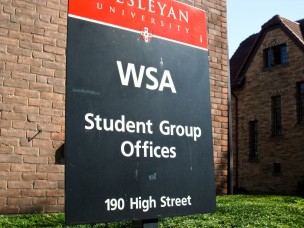
Shauna Pratt/Staff Photographer
Although Wesleyan Student Assembly (WSA) members rarely use the building at 190 High Street, since 2008 the sign out front has read “WSA.” The signage has long been a source of both confusion and tension between the WSA and the numerous student groups that share the building. After some debate, the WSA voted to relinquish control of the sign to groups that use the building.
Certain members of the WSA resisted the change, including Coordinator of the WSA Arya Alizadeh ’13.
“Some people see the 190 High Street Building as a source of pride for the WSA,” Alizadeh wrote in an email to The Argus. “I was one of the few students who was not totally in favor of the sign decision leaving the WSA. My view was that the WSA conceded something which we may not be able to get back in the future.”
Grace Zimmerman ’13, who is the WSA Committee Chair of the Community Outreach Committee and acts as the steward of the space, said she had expected the process to go smoother than it did.
“The WSA is a student assembly here to represent the interests of students,” Zimmerman said. “If the students want the sign changed, I don’t understand what possible reason there could be to not change it.”
For the past three years, the headquarters of the University Organizing Center (UOC) at 190 High Street has been a space for student activism groups to assemble. Currently the building is shared by the UOC, Hermes, the Students of Color Coalition, the Queer Resource Center, and the WSA.
UOC interns Meggie McGuire ’12 and Leo Liu ’14 play an active role in maintaining the physical building as well as expanding student use of the space.
Originally, the building held WSA offices, but the group has had a limited activity in the space since the move to their current office in the Usdan University Center. McGuire explained that the Assembly is in charge of allocating the basement offices.
“The extent to which [the building is a WSA building] now is basically just in name,” McGuire said.
McGuire wanted the sign to reflect that the space is primarily a center for student activism. Zimmerman agreed and ensured that the issue would be on the WSA agenda.
According to McGuire, about 12 students who use the space, including Liu and herself, voiced their opinions at a WSA meeting. They proposed that the decision about the new text of the sign be ceded to those who use the space, including two WSA members.
To some, controversy over the sign is symbolic of a gap between the student body and the WSA.
“It’s exactly issues like these that prevent the WSA from having a real impact on student life,” Zimmerman said. “I would have hoped that the WSA would have viewed this as something minor.”
In the next few weeks, representatives from each of the groups that use the space will decide on an appropriate name for the sign.
“The sign doesn’t really matter that much, but it is symbolic that this is a space that will be around for years to come that has an investment from the administration and from students,” McGuire said. “I was ridiculously happy about the change.”